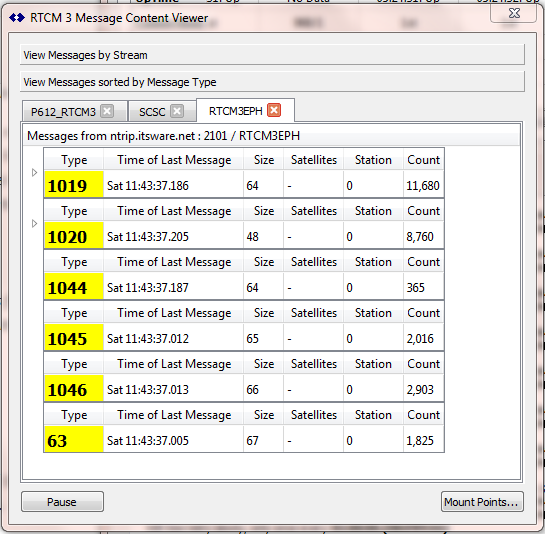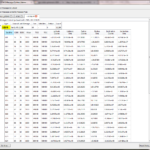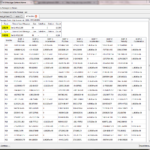Instructions for displaying the contents of RTCM ephemeris (orbital) data message types 1019 and 1020.
When something is not working in a GNSS navigation filter, it is often helpful to look at the ephemeris data that is input to the filter. This orbital data is needed in order to make any type of navigation filter work. In some systems each rover device obtains this locally (by decoding the SVs in view to at it’s location), while in other systems an NTRIP Caster such as SNIP provides it. There are advantages to both, and the best designs often use a hybrid approach. When the ephemeris data comes from a stream on a SNIP Caster, then the RTCM Content Viewer dialog can be used to look at the message contents.
Hint: The SNIP open caster found at ntrip.use-snip.com:2101 provides a complete set of world wide broadcast ephemeris data which you are welcome to connect to and use in your own system. There are several public services which provide similar data streams, and well as services which provide more precise orbital and clock correction information.
How To…
To enable RTCM3 decoding the selected stream must be parsed. And of course it must contain messages in an RTCM3 form (other content can also be present but will be ignored).
- On any stream’s display (for any stream type in a tab display)
right-click and be sure the Parse check box is active. - Select the Show in RTCM3 Viewer menu item to start the RTCM3 decoder dialog,
the dialog will appear with the selected stream in its own tab. - Click on the small arrows on the right side on any message type,
the view will be expanded to show the detailed contents of that message. - Resize the display window as needed when many items are expanded.
In order to see the last (most current) message of a given type, switch to the “View Messages sorted by Message Type” mode. The dialog display starts in this mode, but may be in the “View Messages by Stream” mode if it was used before. As new messages arrive, the data shown in each tab will be updated. You can also stop the display from updating with the Pause button at the bottom of the dialog.
If the menu item Show in RTCM3 Viewer menu item is greyed out, re-confirm that the Parse menu item is checked. If the dialog appears but no data is shown, then no RTCM3 message content has been found in the stream to decode.
Hint: Rather than invoke this dialog with its more detailed decoding, if you are simply interested to learn if a message type exists in the data stream; just use the Show Message Types menu item. If the stream is being parsed, a precise listing of the messages that are decoded will be sent to the console as they occur. If the stream is not parsed, then SNIP‘s universal decoder will provide a rough summary of the data contents it can decode. Be sure to uncheck this menu item when done, as it causes a considerable amount of console log clutter.
This is quick way to discover if a Base Station is sending in proprietary messages, rather then the RTCM3 you thought. It is also useful to discover that a station is sending in unwanted NMEA-183 message content (which would be corrected not in SNIP but by proper setup of the Base Station). [When SNIP is Parsing a stream for RTCM3 content, such extraneous content is filtered out and is not sent to the NTRIP Clients.]
Often Base Stations are set up not to send ephemeris messages at all. The general point of view is that this is wasteful of precious bandwidth to the NTRIP Clients, who can normally obtain the same information (perhaps after a ~25 second start-up delay).
Typical Data Content
Here is a typical display for a stream called “RTCM3EMP” which is sending ephemeris for the GPS, GLONASS, Galileo, and Compass GNSS systems. Basically this represents a single stream containing all the current broadcast orbits for all the SVs in the world.

The two arrows along the left side indicate that message types 1019 and 1020 are fully decoded and can be expanded (the the other message types are not). Expanding either of these creates a display with the most current key orbital details. Click on the images below to see each group decoded and shown at full scale.
In reviewing the above data, recall that the GPS ephemeris is expressed using Kepler equations, while the GLONASS system uses an XYZ dot product format. Unlike observational data that changes with every update (typically every second), the precise message content for ephemeris information only changes when a new orbit is issued by the GNSS ground control segment for that system.
See Also
These articles contain similar information about decoding other common RTCM message types
Viewing RTCM 1004 and 1012 messages


